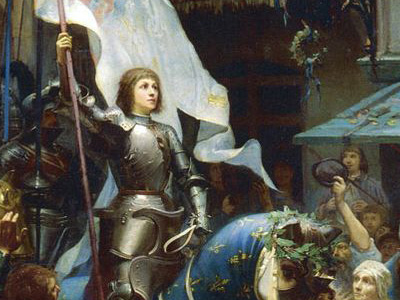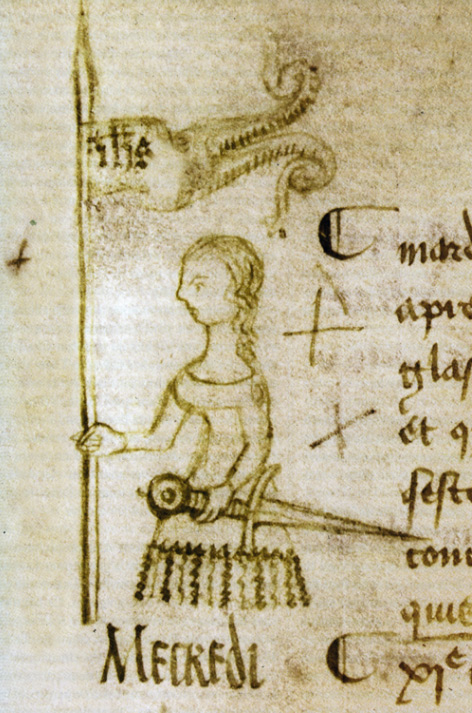Joan of Arc (1412-1431)
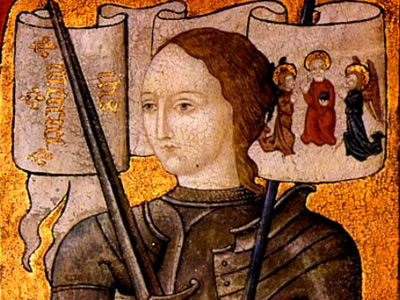
Rise
Robert de Baudricourt granted Joan an escort to visit Chinon after news from Orleans confirmed her assertion of the defeat. She made the journey through hostile Burgundian territory disguised as a male soldier, a fact which would later lead to charges of "cross-dressing" against her, although her escort viewed it as a normal precaution. Two of the members of her escort said they and the people of Vaucouleurs provided her with this clothing, and had suggested it to her.
Joan's first meeting with the Charles took place at the Royal Court at Chinon in 1429, when she was aged 17 and he 26. After arriving at the Court she made a strong impression on Charles during a private conference with him. During this time Charles' mother-in-law Yolande of Aragon was planning to finance a relief expedition to Orléans. Joan asked for permission to travel with the army and wear protective armor, which was provided by the Royal government. She depended on donated items for her armor, horse, sword, banner, and other items utilized by her entourage. Historian Stephen W. Richey explains her attraction to the royal court by pointing out that they may have viewed her as the only source of hope for a regime that was near collapse:
After years of one humiliating defeat after another, both the military and civil leadership of France were demoralized and discredited. When the Dauphin Charles granted Joan's urgent request to be equipped for war and placed at the head of his army, his decision must have been based in large part on the knowledge that every orthodox, every rational option had been tried and had failed. Only a regime in the final straits of desperation would pay any heed to an illiterate farm girl who claimed that the voice of God was instructing her to take charge of her country's army and lead it to victory
Upon her arrival on the scene, Joan of Arc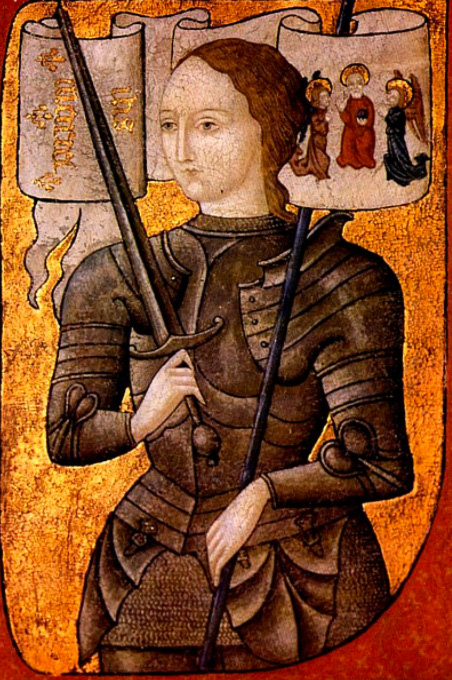 Joan of Arc (1412-1431), is considered a heroine of France for her role during the Lancastrian phase of the Hundred Years' War and was canonized as a Roman Catholic saint. She gained prominence after the siege was lifted only nine days later. This long-awaited event boosted French morale and paved the way for the final French victory. Joan of Arc » effectively turned the longstanding Anglo-French conflict into a religious war, a course of action that was not without risk. Charles' advisers were worried that unless Joan's orthodoxy could be established beyond doubt—that she was not a heretic or a sorceress—Charles' enemies could easily make the allegation that his crown was a gift from the devil. To circumvent this possibility, the Dauphin ordered background inquiries and a theological examination at Poitiers to verify her morality. In April 1429, the commission of inquiry "declared her to be of irreproachable life, a good Christian, possessed of the virtues of humility, honesty and simplicity." The theologians at Poitiers did not render a decision on the issue of divine inspiration; rather, they informed the Dauphin that there was a "favorable presumption" to be made on the divine nature of her mission. This was enough for Charles, but they also stated that he had an obligation to put Joan to the test. "To doubt or abandon her without suspicion of evil would be to repudiate the Holy Spirit and to become unworthy of God's aid", they declared. They recommended that her claims should be put to the test by seeing if she could lift the siege of Orléans as she had predicted.
Joan of Arc (1412-1431), is considered a heroine of France for her role during the Lancastrian phase of the Hundred Years' War and was canonized as a Roman Catholic saint. She gained prominence after the siege was lifted only nine days later. This long-awaited event boosted French morale and paved the way for the final French victory. Joan of Arc » effectively turned the longstanding Anglo-French conflict into a religious war, a course of action that was not without risk. Charles' advisers were worried that unless Joan's orthodoxy could be established beyond doubt—that she was not a heretic or a sorceress—Charles' enemies could easily make the allegation that his crown was a gift from the devil. To circumvent this possibility, the Dauphin ordered background inquiries and a theological examination at Poitiers to verify her morality. In April 1429, the commission of inquiry "declared her to be of irreproachable life, a good Christian, possessed of the virtues of humility, honesty and simplicity." The theologians at Poitiers did not render a decision on the issue of divine inspiration; rather, they informed the Dauphin that there was a "favorable presumption" to be made on the divine nature of her mission. This was enough for Charles, but they also stated that he had an obligation to put Joan to the test. "To doubt or abandon her without suspicion of evil would be to repudiate the Holy Spirit and to become unworthy of God's aid", they declared. They recommended that her claims should be put to the test by seeing if she could lift the siege of Orléans as she had predicted.
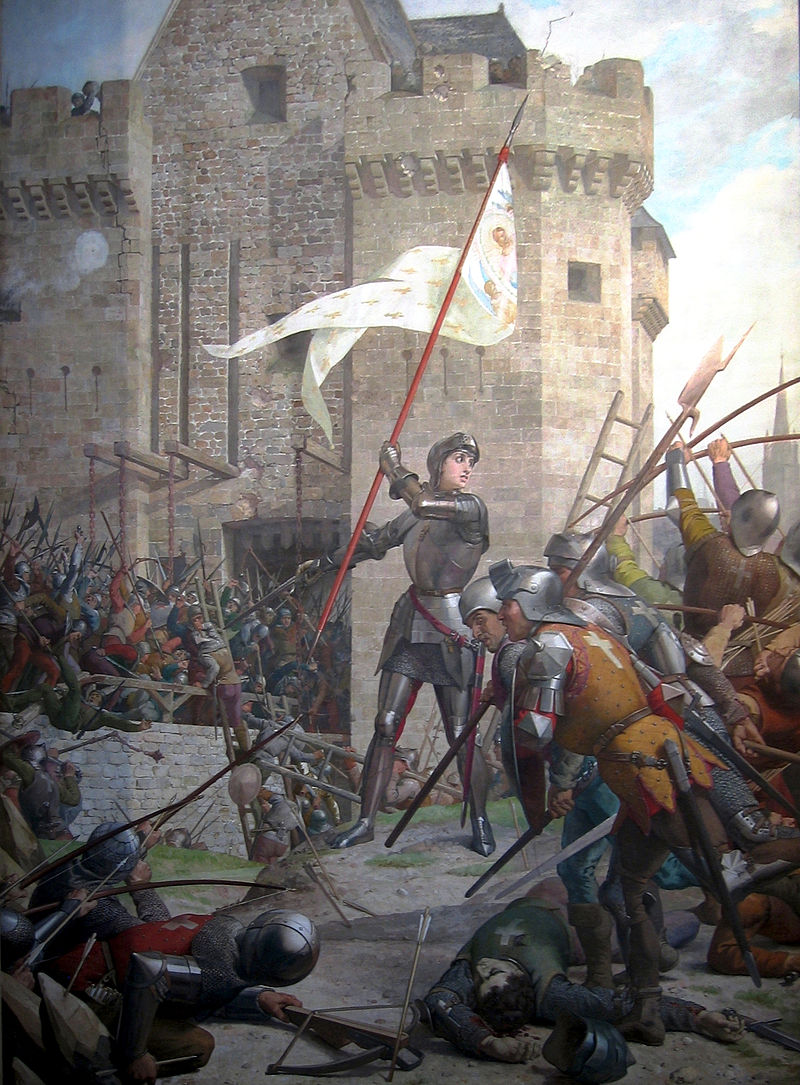
She arrived at the besieged city of Orléans on 29 April 1429. Jean d'Orléans, the acting head of the ducal family of Orléans on behalf of his captive half-brother, initially excluded her from war councils and failed to inform her when the army engaged the enemy. However, his decision to exclude her did not prevent her presence at most councils and battles.
The extent of her actual military participation and leadership is a subject of debate among historians. On the one hand, Joan stated that she carried her banner in battle and had never killed anyone, preferring her banner "forty times" better than a sword; and the army was always directly commanded by a nobleman, such as the Duke of Alençon for example. On the other hand, many of these same noblemen stated that Joan had a profound effect on their decisions since they often accepted the advice she gave them, believing her advice was divinely inspired. In either case, historians agree that the French The Kingdom of France is the historiographical name or umbrella term given to various political entities of France in the medieval and early modern period. It was one of the most powerful states in Europe since the High Middle Ages. It was also an early colonial power, with possessions around the world. Colonial conflicts with Great Britain led to the loss of much of its North American holdings by 1763. The Kingdom of France adopted a written constitution in 1791, but the Kingdom was abolished a year later and replaced with the First French Republic. army enjoyed remarkable success during her brief time with it.
The Kingdom of France is the historiographical name or umbrella term given to various political entities of France in the medieval and early modern period. It was one of the most powerful states in Europe since the High Middle Ages. It was also an early colonial power, with possessions around the world. Colonial conflicts with Great Britain led to the loss of much of its North American holdings by 1763. The Kingdom of France adopted a written constitution in 1791, but the Kingdom was abolished a year later and replaced with the First French Republic. army enjoyed remarkable success during her brief time with it.
HISTORY
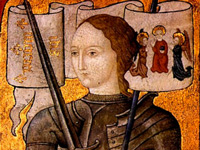
RESOURCES
This article uses material from the Wikipedia article "Joan of Arc (1412-1431)", which is released under the Creative Commons Attribution-Share-Alike License 3.0.
© Stories Preschool. All Rights Reserved.
